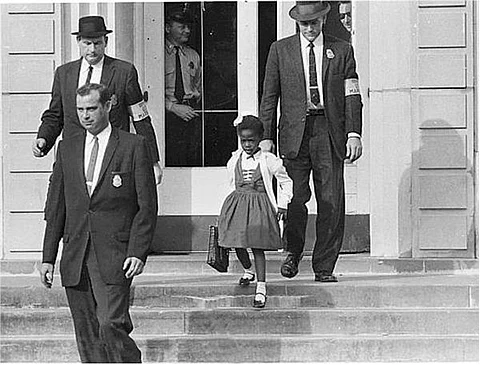

Ruby Nell Bridges, born and raised in Mississippi, fought racism at the age of 6 and became a symbol of African-Americans all across the nation. This Black History Month 2021, we celebrate heroes such as Ruby Bridges, who played a substantially contributing role in shaping the history of African-Americans nationally.
Ruby Bridges Early Life
Ruby Bridges belonged to a lower-class family and was the eldest of eight siblings. Her family moved to New Orleans when she was just four years old. Bridges was amongst the six African-American students selected to enroll in an all-white school, William Frantz Elementary School.
On her first day at school on November 14, 1960, Ruby Bridges was escorted to school by four federal marshals and she spent the entire day in the principal's office. At the age of 6, Ruby Bridges became the first African-American student to enroll and study in an all-white school, despite the angry crowd spurring negative and hateful comments at her.

On her second day at school, Ruby Bridges was taught in a vacant classroom by a young teacher named Barbara Henry. However, the Marshals did not stop escorting Ruby Bridges every day to school for a year. They insisted she kept her eyes forward to avoid seeing the negative remarks written on the boards held by angry and spiteful protestors outside her school. Protesters' fury lasted for only a year, as the crown began to lose interest and more African-American students enrolled in William Frantz Elementary School by the end of the year.
How Did Ruby Bridge's Family Faced Discrimination?
Ruby Bridges enrollment in an all-white school caused more than furious protestors. After her enrollment as the only African-American student in a segregated school in New Orleans, Bridge's grandparents were evicted from the farm where they resided for many decades, and her father lost his job too.

Whereas the local grocery store refused to offer any services to her mother. Despite her parents being torn apart in decisions whether to send her to a segregated school or not, they did not want her to miss an opportunity to lead a comfortable and secured life with proper education. Some families supported Ruby Bridge's bravery and showed her support in as many ways as they could, either by sending money to her family or just uttering a few words of encouragement.
Works Inspired by and Based on the Life of Ruby Bridge
In 1964, artist Norman Rockwell painted a portrait of Ruby Bridge celebrating her resilience, strength, and courage of her first day in school as she walked in between the four marshals. The title of that painting was "The Problems We All Live With."
In 1995, Ruby Bridge's story was retold in "The Story of Ruby Bridges" by author Robert Cole. In this children's book, the author included conversations with bridges as a source of authenticity.

In 1993, Ruby Bridge's began her career at William Frantz Elementary School. By the time Bridge's started working there, it had already become an all-Black school.
In 1999, Ruby Bridges established the Ruby Bridges Foundation, an educational platform that strived to promote unity, harmony, and tolerance amongst schoolchildren of all ages. In the same year, Bridge's memoir, Through My Eyes, was released which depicted some of the most exciting and courageous stories from her life.
In 2009, Ruby Bridges wrote and published a children's book, Ruby Bridges Goes to School: My True Story.
In 2000, in a ceremony in Washington DC, Ruby Bridges was made an honorary deputy marshall.
Ruby Bridges Life Story – What Do We Learn From It?
Ruby Bridge's life story is real, it is not fictitious, nor is it made-up. Residing in a community where people's worth was determined from the color of their skin, she fought against the racial standards and paved the way for success and equal educational opportunities for African American students across the United States.

At an age where she did not even know the true meaning of racism and discrimination, Ruby Bridges had to hear unimaginably horrid words, slurs, and comments from protestors who despised her very existence just because she was a person of color. Thanks to Ruby Bridges and many heroes like her, African Americans in the States are now able to get equal educational and professional opportunities, without being discriminated against.
What do we learn from Ruby Bridge's life story? You do not have to be old enough to make a difference, you aren't 'too young' to make a difference. There is no 'perfect age' to do the right thing. Society has molded our minds in such a way that we have a hard time taking youngsters and teenagers seriously. When they are passionate about something, we call it 'dramatic' or 'emotional.'
Ruby Bridges used her painful past to inspire many African Americans across the United States. She used her talents for the betterment of her community and became a symbol of strength nationally. Being a lifelong activist for racial equality, Ruby Bridges played amongst the most substantially contributing roles in shaping history and inspiring activists globally.
